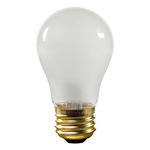Standard Light Bulbs
Even with the widespread shift to energy-efficient lighting, incandescent bulbs continue to hold their place in homes and specialty applications. Known for their warm glow, full dimmability, and instant brightness, incandescent light bulbs remain a trusted choice for decorative, appliance, and high-output commercial use.
Are Incandescent Bulbs Dimmable?
Yes, all incandescent bulbs are dimmable and compatible with most standard dimmers. However, we don’t recommend using incandescent bulbs with LED-specific dimmers unless they support multiple bulb technologies. For best results, pair your bulbs with a dimmer that matches the technology type.
Can I Use a Higher Wattage Bulb Than Recommended on a Lamp?
If you're switching to LED, you can use a higher wattage equivalent as long as the actual wattage stays below the fixture’s rating. For example, a 100W LED bulb typically consumes only 15–20 watts. However, you should never use a 100W incandescent bulb in a fixture rated for 60W, as it can cause overheating or fire risks.
3-Way, Appliance, and Rough Service Light Bulbs
Incandescent bulbs are still widely used for:
- Appliances: Appliance bulbs are designed for ovens, refrigerators, and microwaves. Compact, lower-wattage options include 15W and 25W options.
- Ceiling Fans: Use reinforced filaments to endure vibration.
- Rough Service: Built for high-vibration areas like garages and workshops, with durable filaments and shatter-resistant coatings.
- 3-Way Bulbs: Dual-filament bulbs that offer low, medium, and high light levels (e.g., 30/70/100W or 50/100/150W).
Incandescent Bulb Shapes and Sizes
Most household incandescent bulbs come in standard A-shapes like A19 and A21, where the number indicates the bulb's diameter in eighths of an inch.
For higher-output needs, look for PS-shaped bulbs like 300W or 500–1500W versions. These often use a mogul E39 base instead of a standard medium E26.
Where Incandescent Still Shines
- Warm, ambient glow unmatched by LED
- Dimmability across all models
- Low upfront cost for short-term or low-usage applications
- Specialty use in legacy fixtures or appliances
Need outdoor-friendly options? Try our yellow bug light bulbs designed to reduce insect attraction.
Frequently Asked Questions
What is an incandescent light bulb?
An incandescent bulb produces light by passing electricity through a tungsten filament, which glows and emits a warm light.
Are incandescent bulbs illegal?
Many general-use incandescents have been phased out by energy regulations, but appliance bulbs, rough service bulbs, and high-wattage PS bulbs are still legal and available.
Can you still buy incandescent light bulbs?
Yes. 1000Bulbs offers a wide selection of incandescent bulbs for appliances, decorative uses, and specialty applications.
Are incandescent bulbs dimmable?
Yes, all incandescent bulbs are fully dimmable with standard dimmer switches.
Can I use a higher wattage incandescent bulb in my fixture?
No. Always follow the fixture’s maximum wattage rating to avoid overheating or fire hazards.
Need help choosing the right incandescent bulb? Call our team at 1-877-767-3860 and let our lighting experts assist you today!







